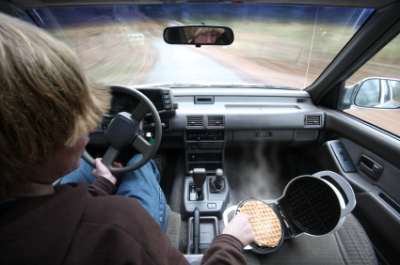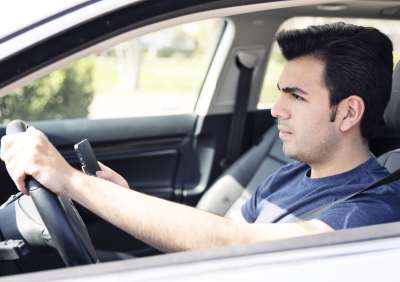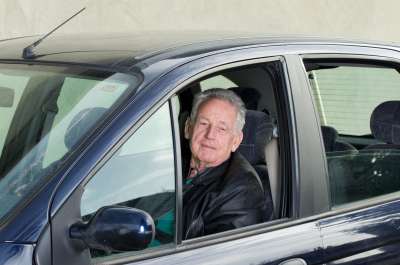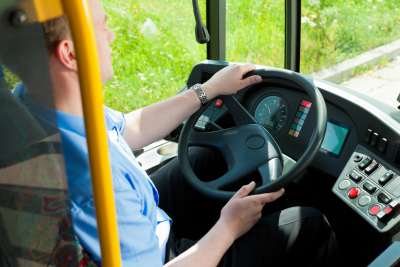 Driving while not paying attention to the road is one of the most dangerous things a person can do. During driver training, we are told to always have our eyes on the road, look to strategic spots and blind spots for signs of trouble, watch what the other drivers on the road are doing and always being aware of our surroundings. Even a task as simple as pulling out of the driveway requires a driver's full attention: what's behind you, in front and beside you (garbage cans, toys, bicycles, people etc).
Driving while not paying attention to the road is one of the most dangerous things a person can do. During driver training, we are told to always have our eyes on the road, look to strategic spots and blind spots for signs of trouble, watch what the other drivers on the road are doing and always being aware of our surroundings. Even a task as simple as pulling out of the driveway requires a driver's full attention: what's behind you, in front and beside you (garbage cans, toys, bicycles, people etc).
When you are in the driver's seat of a vehicle, there is no room to do anything other than drive responsibly. In fact, it is such a vital part of safe driving that most people think that texting while driving should be a criminal offence. A simple ticket and fine, are no longer thought of as sufficient.
Below is a comprehensive guide to different resources that will help you learn about distracted driving, laws and fines, and the effects of being distracted on the road.
Table of Contents
- Distracted Driving - A Guide
- Teens
- Parents
- Teachers
- Seniors
- Commercial Drivers, Public Service and Emergency Workers
- Rural
- Factory, Construction and Trade Workers
- Motorcyclists
- Cyclists
Distracted Driving - A Guide
Distracted driving is becoming more commonplace on the road, and accidents caused by distracted driving kill and injure more people than drunk drivers. Each year, distracted drivers cause about 16 per cent of fatalities and 20 per cent of injuries in collisions (2009 statistic). Distractions can increase the odds of getting into a crash or a near crash. Outside distractions such as watching an accident scene or looking at billboards and street signs can also contribute to these risks.

Use common sense. If you are sleepy, hungry, have to make a call, or need to help a passenger, pull off to the side of the road - to a safe spot. And, if there is an accident scene or other outside distraction, do not get caught up looking at it.
Click on the links below to learn more:
- What is distracted driving?
- Top Four Admitted Distractions (infographic)
- Canada Speaks on Distracted Driving (infographic)
- Distracted Driving Bad Habits
- List of Top Distractions
- Tips to Avoid Distracted Driving
- Costs of Distracted Driving
- Distracted Driving and Insurance
- Avoiding Driving Distractions
Each province and territory has different penalties, fines and demerit points for distracted driving. To learn about different legislations in Canada's provinces and territories, click on one of these links:

- Demerits and Fines across Canada
- Distracted Driving Laws in Canada (CBC article)
- Ontario Legislation
- Alberta Legislation
- British Columbia Legislation
- Quebec Legislation
- New Brunswick Legislation
- Prince Edward Island Legislation
- Nova Scotia Legislation
- Newfoundland Legislation
- Yukon Legislation
- North West Territories Legislation
In some areas, drivers have some exceptions to the distracted driving rules concerning cell phones. There is often legislation that allows for communication devices to be used in hands-free mode. This means that the mobile devices are typically used with a headset, Bluetooth or earpiece, or used on speakerphone, and when used as such-properly-may be exempted from the "no cell phone use" rule depending on the local legislation. Depending on the area, exemptions may include:
- GPS devices used in hands-free mode.
- Collision avoidance systems
- Display screens providing information on road and weather conditions, or those providing information on the immediate environment of the vehicle -e.g. screens allowing drivers to see behind the vehicle while backing up
- Hands-free hand-mike and portable-radio (walkie-talkie) used by hands-free application such as a lapel button or any other hands-free application.
If you need to call 911, you may also be exempted; just make sure that, if possible, you drive to a safe spot to make the call and do not disrupt traffic. Learn more about hands-free legislation.
Teens
Teens are especially vulnerable to the effects of distracted driving. And, although texting and talking on their cell phones are two of the biggest distractions for teens, the presence of friends in the car can also be a distraction.
A 2005 Statistics Canada report says that although Canadian teenagers 15 to 19 years old represent less than 7 per cent of the total population, they represent 19 per cent of all passenger fatalities and 19 per cent of all serious injuries to passengers in Canada. When there is an accident, the situation affects not only you but everyone in your life-moms, dads, grandparents, siblings, aunts, uncles, cousins and friends. So, to be safe:

- Put the phone away
- Let the front seat passenger change CD's, radio stations or select music on your MP3 player
- Comments and joking around should be kept to a minimum, and should never distract the driver.
- NEVER allow passengers to unbuckle and climb around inside a moving car.
- If you are tired, pull over at a safe spot to rest.
For more tips:
- Distracted Driving and cell phones
- Cell phones and Driving
- Texting
- Ontario Provincial Police - Talking to young adults about driving habits (video)
- Teens and Distracted Driving
- Distracted To Death
- Distracted Driving Game (University of Minnesota)
Parents
Parents are the first people that children look to for example. So, it is up to parents to live by example - whether it is by exhibiting ethical behaviour, love or respect. This "learn by example" behaviour should also be shown when parents are driving. Be responsible, show respect for others on the road, and do not be distracted while driving. Live by the actions that you would like your children to exhibit.
Distracted Parents
Next to teenagers, parents, particularly those of infants or small children, are some of the most distracted drivers on the road. According to the Canadian Automobile Association (CAA), small children are four times more distracting than adult passengers, and infants are 8 times more distracting.
There is probably nothing more unsettling than listening to an uncomfortable child in the back seat. A parent's first instinct is to take action immediately and comfort the little one. Find a safe spot, preferably not on the shoulder of the road, and take care of the young one's needs. It's better to let the baby cry for a bit and avoid the possibility of an accident.

To learn more:
- Driving Simulator
- A mum's look at parents and distracted Driving
- Parent Drivers - A report by cnet.com
- Avoiding Driving Distractions
- Statistics on Driving with children
- How some toddler toys teach bad driving habits
To keep your children happy and occupied on the road, there are a number of resources that provide activities for them. To get you started:
Teaching your children
It is important to start teaching your children about safe driving at an early age. They do not have to be in driver training to begin understanding road safety.
Toddlers and Young Children
Toddlers and young children will bicker in the confined space of a vehicle, and the quarrelling is hard to ignore. If you are unable to stop the arguing or control interruptions in the backseat, it may serve you well to give children their own diversions. Keep them busy. You may not be able to stop the arguing, but you can lessen the frequency:

- Teach them car games
- Give them their favourite books
- Stick in a DVD for them to watch. If your vehicle is not set up with a built-in system, buy an inexpensive system - preferably one for each child, equipped with headphones.
- Provide hand-held devices such as game units, tablets. laptops or smart phones
- Help them plan what they want to do while travelling
There are some websites that are child-friendly, where children can learn and participate in games and activities that teach them about distracted driving at a level they can understand. For more information:
Teenagers and Young Adult Drivers

Even before they drive, your children need to understand the rules while on the road. Be an example, and help them while they are learning. Trying to teach a teenager can be difficult and more than likely, there will be conflict, but with some of these resources, you can be a better source of information and guidance for your child.
To help your young driver learn to be a safe and responsible driver, take a look at the links below:
- Advice for parents
- Top 10 driving distractions
- Communicating with your young driver
- Parents, teens and distracted Driving
Teachers

School teachers in all grades can start a child's education on distracted driving. There are many exercises and websites online that are geared towards elementary and secondary school students, including:
- A Comprehensive lesson plan for students - Education World
- Interactive activities - Scholastic.com
- Downloads and printouts for student exercises
- Teacher resources and information
Seniors
In experienced, new drivers are not the only ones vulnerable to driving distractions. With seniors, distracted driving is also common. Inattentional blindness - the inability to be aware of objects that are clearly visible - is one issue that seniors may face and that may affect their driving. Many seniors like to drive, as it is a way of staying independent, but changes in health and flexibility can put them, and other drivers, at risk on the road. Some common issues that arise as a driver ages include:

- Depth perception and ability to judge speed can deteriorate
- Decreased visibility at dusk and night.
- Sensitivity to light and glare of oncoming traffic
- Decreased reaction times due to changes in flexibility.
- Driving risks associated with medication side effects, such as drowsiness.
- Diminished memory or ability to respond well in stressful situations
- Injruy, disease or illness can also affect driving ability. This can affect anybody at any age, but seniors are more likely to experience these effects.
If you find that you, or an older person in your life, is having trouble driving, it may be time to consider whether driving is feasible any longer. It will be difficult for all involved, but it is sometimes necessary.
For more information:
- Inattentional Blindness
- Medications and their effects on driving ability - American Automobile Association
- Driving tips for seniors
Commercial Drivers, Public Service and Emergency Workers
Anybody who drives for a living, or uses a vehicle to do the majority of their work are more likely to have something or someone distracting them while they are driving. These drivers can be distracted by:
- Passengers
- Communication with co-workers, such as a foreperson or head office, while driving
- GPS systems
There are special circumstances for these drivers. While drivers of passenger vehicles cannot use the phone while driving, drivers of vehicles used in a public service or commercial capacity - such as city buses, maintenance/utility vehicles and emergency vehicles - may be exempted.
Emergency Drivers

Those who drive police, fire, or ambulance vehicles are encouraged to use hands-free communication devices when working, but that is sometimes impossible, so they are typically exempted from the display screen and hand-held wireless communication device ban in the performance of their duties.
For more information, see:
Bus Drivers

Bus drivers - school, city transit and coach - face all kinds of distractions each day as they move people from place to place. The driver is responsible for ensuring a safe ride for all who are on the bus. A bus driver has to concentrate on the road, and manoeuvre an extra large vehicle through city streets. Make sure passengers understand the importance of riding rules.
For more information:
Passengers
As a transit passenger, there are things that you can do to make your next ride safe for everyone.

- When you get on the bus and pay your fare, go straight to your seat
- Sit quietly
- When you ring the bell for your stop, do not get up from your seat until the bus comes to a complete stop. As soon as you get up, the bus driver will notice, and will put their concentration on making sure that you do not fall. When they are looking at you, the bus is not moving safely. And, if the bus stops quickly, hits a pothole, or lurches forward, you may get hurt.
To learn more on school bus safety, click on the links below.
For more information on city bus safety:
Maintenance, Utility and Commercial Workers
Maintenance and utility workers are always on the move. From everyday maintenance to emergency calls, they are the ones we depend on to ensure that our cities and towns are running smoothly.
To make driving easier and safer:
- Understand blind spots
- Ensure proper driver training
- If there are two or more people in the truck, let one of the passengers handle communications.

For more information:
- Distracted driving and the workplace
- Videos on driver distraction in the workplace
- The cost of distracted driving
- Workplace safety - distracted driving
- Workplace toolkit - Project Health
- Driver exemptions
- Commercial drivers guide -Transportation Alberta
- Driver education for commercial drivers
Rural
In 2009, 30.232 people were injured and 1,154 died on rural roads (Transport Canada road statistics). Cars, pickups and huge farm vehicles such as combines and tractors all share the road. The different speeds and capabilities of these different vehicles means that all drivers have to pay very close attention on rural roads.
Cars Travelling on Rural Roads

Rural roads are, much of the time, quiet. Fewer people travel on these roads, and when you are the only one on the road, you tend to have more relaxed driving habits, and can easily rationalise a quick phone call or text. The boredom of a rural road can also mean that a driver can get tired quickly.
Keep safe on rural roads by:
- Keeping an eye on the road at all times
- Not using your phone
- Keeping a safe and lawful speed, even if the road is empty.
For more information:
Farm workers

Farm workers also need to pay attention to the road. Farm vehicles are not as easy to manoeuvre, and they are much slower than cars and pickups. Following some simple rules can help keep farmers safe on rural roads:
- Pay attention to the road
- Understand the blind spots on every vehicle/piece of equipment that not only goes on public roads, but is driven in the fields and around farm buildings
- Know how to drive the vehicle. That includes getting trained and asking any questions.
For more information:
All Terrain Vehicles
All Terrain Vehicles, known as ATV's or Off Road Vehicles (ORV's) are driven by many on country roads and across farmland and other country terrain. In most provinces, drivers need some form of licence or permit to ride. It is important to understand the legislation that is in place for the province you live in BEFORE you go out riding. In some provinces, these vehicles are required to be licensed.

In order to keep your eyes on the (off) road, have fun and stay safe, you have to know what you can and cannot do on it. DO NOT take it to areas that are beyond your skills and that you would have to take your eyes away from the road.
- Ensure proper training
- Know the vehicle's limits and know YOUR limits
- Keep a safe speed.
- Make sure the proper permits and insurance are in place
- Wear a helmet
- No texting or phoning
- Be aware of the terrain
To learn more:
- ATV safety - Ontario's Ministry of Transportation
- ATV insurance - Manitoba
- ATV laws
- ATV drinking and driving deaths
Factory, Construction and Trade Workers

Keep distractions to a minimum, make sure:
- Proper training is in place, through the workplace and through coursework.
- There are no distractions other than ones that are allowed by law
- Ensure your employer is committed to safety.
For more information:
- Forklift Drivers
- Forklift Safety
- Driver Distractions
- Construction and Trades
- Distracted Driving
- The cost of distracted driving in the workplace
Motorcyclists
Motorcycles, mopeds, and scooters all are road vehicles and their drivers are subject to the same rules as other drivers on the roads. That means that distracted driving legislation applies to them as well. But, they also have to watch for vehicles most of which are bigger than they are. Bad behaviour by car and truck drivers can be a distraction to a motorcyclist. To stay safe on the road:

- Know the rules - get training and proper licensing
- Keep your bike in good condition
- Keep a look out for cars, pedestrians and bicycles, and learn how to anticipate the actions of others on the road.
- Go at a decent speed, as you are more vulnerable at higher speeds
- No texting, phoning or headphones
- No grooming or eating/drinking
For more information:
- Motorcycles, scooters, e-bikes, mopeds and tricycles-Kanetix
- Common mistakes made by motorcyclists - Kanetix
- Riding advice with a very funny, informative video - ridesotpngo.com
- Safety tips for motorcyclists - insurancehotline.com
- Important tips for motorcyclists - insurancehotline.com
- Riding distractions to avoid
- 9 sources of distraction - lizjansen.com
Cyclists
Cyclists, like motorcyclists, have to also pay heed. Bicycles do not move as fast as other vehicles on the road and there are other dangers that are not considered, such as the wind drag caused by a passing vehicle, and a vehicle that passes too close. You do not need a licence to ride a bike. But, like motorcyclists, bad behaviour by other drivers can be a distraction. To keep distractions to a minimum:

- Know the rules of the road
- Wear a helmet
- Use the proper hand signals
- Always watch the road for potholes, vehicles (and their doors), pedestrians
- Learn how to manoeuvre safely across train tracks
- Stay off of busier roads when possible.
- Keep your bike in good condition
- Wear bright clothing and light the bike at night
- No texting, phoning, or headphones
- No grooming or eating/drinking
To learn more:
- Bike safety - CAA
- Common car-bike collisions - City of Toronto
- Long-distance cycling tips
- Cycling distractions - velojoy.com
- Distracted cycling - kitsilano.ca
Distracted drivers-of all types and ages-cause havoc on the roadways. Not paying attention puts you and your passengers, not to mention others on the road, at risk. When you look at it, it makes sense to just keep your eyes on the prize - a safe arrival. We all share the road, so being a distraction to someone else is not smart. Additionally, it's likely that soon an infraction will affect your demerit points, and ultimately your car insurance rate.
By: Walter Zeiss
